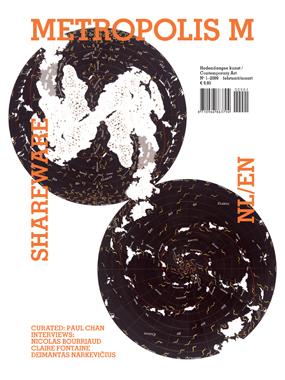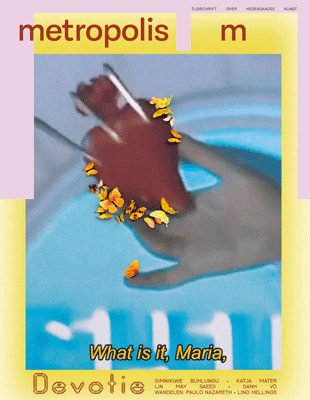Redirecting Roles
Redirecting Roles
Art from Palestine and the Media
How to write about contemporary Palestinian art in a few thousand words? Obviously an overview doing justice to practice and context is impossible and would require much more space than the scope of this article allows. Indeed, how does one write today about artistic practice in and from the Middle East, about Palestine in particular, without an eye that is a priori tainted and conditioned to expect and judge in terms of aesthetics, thematics, and representation? I have therefore chosen to focus on artists who take exactly the quandaries of perception and representation, and their subsequent roles as artists and as Palestinians, as their main interest. Here a differentiation of positions, artistic, national, political and identitarian are continuously in flux. Within this context humour, hyperbole, and futurologist projections are not exactly the sensibilities conjured when contemplating the daily hardships of existence under Israeli occupation. Yet it is perhaps precisely because of the absurdity and chronic character of such a long conflict, that humour and hyperbole can be mobilised for critical purposes.[1] Per definition humour and hyperbole’s ambivalence, ‘its ability to shift between the utopian and the destructive; intelligence and stupidity, and its refusal of absolute values’[2] make it a prime strategy for addressing issues pertaining to identity, fear, history, power, and representation of self and others. Moreover, they offer strategies for re-appropriating a subject matter in novel and complex ways. If, as Lebanese writer Bilal Khbeiz has stated about the media depiction of the Arab world, ‘we must die in order to capture the attention of the camera’[3], the aforementioned strategies, allow for an agency, which exerts a different subjectivity, well beyond the generic media images of Palestine and Palestinians. Fed up with being cast in the role of either the victims or the terrorists, in mass media on the left and on the right side of the political spectrum, there is a generation of Palestinian artists who have placed this gesture of assertive remediation at the core of their work. Sexy Semite (2000-2002), a well-known earlier work of award-winning artist Emily Jacir, flooded the Village Voice in the classifieds section with ads of Palestinians looking to settle down with Israelis. Ironically, marriage to an Israeli would be the only way for Palestinians to ‘return’ to their homeland. Taking her practice out of the context of the art institution, Jacir utilised the very medium, namely the newspaper, which depicts the Palestinian narrative in the world politics section as ‘bad news’. By placing ads like: ‘You stole the land. May as well take the women! Redhead Palestinian ready to be colonized by your army’, Jacir collapses a slew of discourses from the inside out in a tongue-in-cheek manner, ranging from the sexual objectification of the oriental woman, the power of the media, the daily burdens of the occupation, to the loopholes of discriminatory legislation. A meta-reading might suggest that within the wider context of the international art world, where art and conflict have become increasingly fashionable topics, Palestinians are indeed ‘sexy semites’, feeding not only a neo-orientalist desire, but also catering to the Eros and Thanatos dynamics of ‘war art’. Humour and irony, are in that sense always Janus-faced. Ramallah-based Ihab Jadallah’s short film The Shooter (2007) capitalises on the genre of the Western, in combination with a system of image representation that obviously has become depleted, or just simply fails. There are no good guys and bad guys anymore in his attempt to tell a Palestinian narrative: his hero is emasculated and mourns the roles Palestinians are always forced to play. Even the international media TV crew – casted as a vehicle to amplify the constructedness of media spin – are at loss how to capture the retinas of tired Western audiences, saturated with images of war in the Middle East. Yet Jadallah’s seven minute long video is as much a contemplation on Western image perception as it is on image production from a Palestinian perspective, and the various responsibilities and frustrations accompanying the latter. ‘Western producers, they never give Palestinians the role of the hero’, Jadallah’s protagonist laments. ‘They show what they want and ignore what they want. This is what Western colonisation is. Intellectual Colonisation’, he continues as he walks into the sunset. Not unlike Jackie Salloum’s Planet of the Arabs (2005), a slick and funky nine-minute montage of Arab stereotypes from Hollywood blockbusters, which to a murderous beat splashes the vilification of Arabs from cartoons to action movies across the screen, Jadallah has imploded and exposed the very mechanism of ideological perception management. This act is in and by itself a reversal of power positions, yet similar as to his defeated hero, eventually little glory is to be found in it.
Role-playing
Working predominantly with video, Jerusalem-born Larissa Sansour has the past years focused her work on suggesting alternative roles for the Palestinian subject. Often humorous and balancing on the absurd, in videos such as Bethlehem Bandolero (2005), Happy Days (2006), Sbara (2008), and A Space Exodus (2008), she scripts a performative hybridity into Palestinian subjectivity by referencing Western pop culture, ranging from spaghetti westerns, American sitcoms, horror films, to science fiction. Her aim is ‘to set the viewer off balance, breaking stereotypes of ethnicity as well as clichés in the frame work of art display.’[4] Moreover, she comments, ‘Palestinians have long been subjects of documentaries and it is not a favourable role to have. I try to subvert that in my work by turning the Palestinian into the commentator or the analyzer.’[5]Sansour always insists to play the latter role herself: whether as a sombrero-clad gunslinger fighting a duel in the midday sun with the separation wall, surrounding her hometown of Bethlehem in Bethlehem Bandolero (2005). Or in Happy Days, a three minute take on the popular 1970’s sitcom, which portrayed an idealized version of life in late 1950s and early 1960s America. Sansour’s version of life in Palestine is of course far from idyllic. By fast forwarding the image, and introducing us in a playful way to the characters (Sansour as the generic Palestinian, the Israeli army, the watchtowers, roadblocks, checkpoints, and historical landmarks in Jerusalem and Bethlehem), she creates a world that appears happy and cute. The harshness of reality couldn’t have been more different. Happy Days offers us a worldview that is completely distorted from what is really happening, sugar-coating every trace of ugliness, conflict or violence. In that sense it reflects much of the impotent political discourse surrounding Palestinian-Israeli dialogue on the ‘peace process’. By hyper-aestheticising her content and her editorial choices by means of special effects and jump cuts, Sansour seduces her viewers in order to subsequently confront them with their own prejudices. Sansour’s practice firmly positions the role of the artist within contemporary Palestinian society. By insisting on playing the starring role in her videos, Sansour suggests that mere observation is not adequate, and that an active direct engagement with the imaginary not only generates agency, but also hope. This attitude is perhaps best articulated in her latest work A Space Exodus (2008), wherein Sansour figures as a Palestinian astronaut, firmly planting a Palestinian flag on the moon. ‘As Palestinians have been completely denied of any immediate or plausible present context, they are free to pick and choose from a plethora of scenarios. The moon seems to be the only viable place left for Palestinians. A land without a people for a people without a land.’[6] In other words, identitarian roles are up for grabs when they are not acknowledged by others. In that sense, Sansour can opt to be the desperado gunfighter, the girl next door, the menacing Arab, the superhero, the astronaut, the artist, and Palestinian all in one. Indicative of the schizophrenia of the Palestinian condition, it also simultaneously highlights the forced adaptability and pluriformity of roles people have to play in order to survive.
Ghost town
Writing on Palestinian filmmaking, Colombia University Professor Hamid Dabashi has aptly asked: ‘What happens when reality becomes too fictive to be fictionalized, too unreal to accommodate any metaphor?’[7] Some artists have heeded that call by ways of creating hyperrealities, where history and lived present experience come together, where dystopic and utopic scenarios meet, and where the preservation of historical and cultural heritage morphs into a futurology which is historical, as well as histrionic. A striking example of this is Wafa Hourani’s project Qalandia 2047, shown in 2007 at the Thessaloniki Biennial and most recently in Beirut’s Sfeir-Semler Gallery’s show In the Middle of the Middle, both curated by Catherine David. Hourani offers us a detailed scale model of how he envisions the Qalandia refugee camp, a century from 1947 when the inhabitants were evicted from their homes, following the creation of the State of Israel. Situated on the road from Jerusalem to Ramallah, Qalandia camp and the Qalandia checkpoint encapsulate literally where Palestine has been divided and cut from its roots, territorially and historically. Scarring the area around Qalandia is the separation wall, which Hourani in his maquette has dressed with mirrors on the Palestinian side. This partly suggests frivolity, but also implies that when the rest of the world is sealed off, one is forced to indulge in narcissism and gaze at oneself. On the other side of the wall, a menacing airstrip with fighter jets reminds us that 100 years onwards, little has changed. Hourani’s Qalandia is strewn with minute and playful details, such as sports cars, TV antennas sculpted into decorative forms and figures, colourful rooftops, flowerpots, photographs, graffiti, and even a real goldfish swimming in a fishbowl. Yet it remains a ghost town, a dollhouse of the occupation, beautified by ornament and mirrors, seeped in inertia. The artist has mapped out a vision as architect, archaeologist, chronicler of a past, and future forecaster. Nevertheless, similar to the goldfish, he remains trapped in a space too confined, in a history too dictating. Conceptual artist Khalil Rabah, has drawn on similar issues, but uses an inverse strategy. Instead of emphasising stasis, he stresses the dynamics of the geo-political present and recent history, by means of the most territorially grounded of disciplines: geology and paleontology. His ongoing project The Palestinian Museum of Natural History and Humankind is a fictitious museum, with departments of Geology & Paleontology, Earth & Solar System, Botanics and Anthropology. It aims to ‘inform, connect, fascinate, amaze, delight, surprise and excite visitors’ interest in the way the world works by focusing on the natural and cultural history of Palestine’. Supposedly established in 1936, Rabah, as the museum’s director, publishes regular newsletters, and participates in exhibitions and biennials with parts of the collection of the Palestinian Museum of Natural History and Humankind. The museum has even teamed up with the equally fictive ‘United States of Palestine Airlines’ as its main sponsor. In addition, the museum organizes auctions and art sales, such as for example the annual Wall Zone Sale, which auctions objects taken from the natural environment around the separation wall, surrounding the West Bank. It is no coincidence that Rabah has chosen a museum of national history, rather than an art museum. On a stretch of land, where archaeology and geology are often used to prove heritage and landownership, the exhibits in The Palestinian Museum of Natural History and Humankind are far from innocent. Rabah brilliantly redeploys the museum as an institutionalised site of power and authority, for an art project which is highly political in content. Which modes of representation and knowledge distribution validate objects worthy of being in a museum’s collection? By naming, archiving and cataloguing Palestine’s natural and cultural heritage Rabah purposefully institutionalises it. Similar to Hourani and Sansour, Rabah takes on the role of scientist, activist, museum director and future forecaster, navigating a space between past and present, the real, and what could be, continuously redirecting perception and representation. Nat Muller is curator and critic, Rotterdam
Nat Muller

















